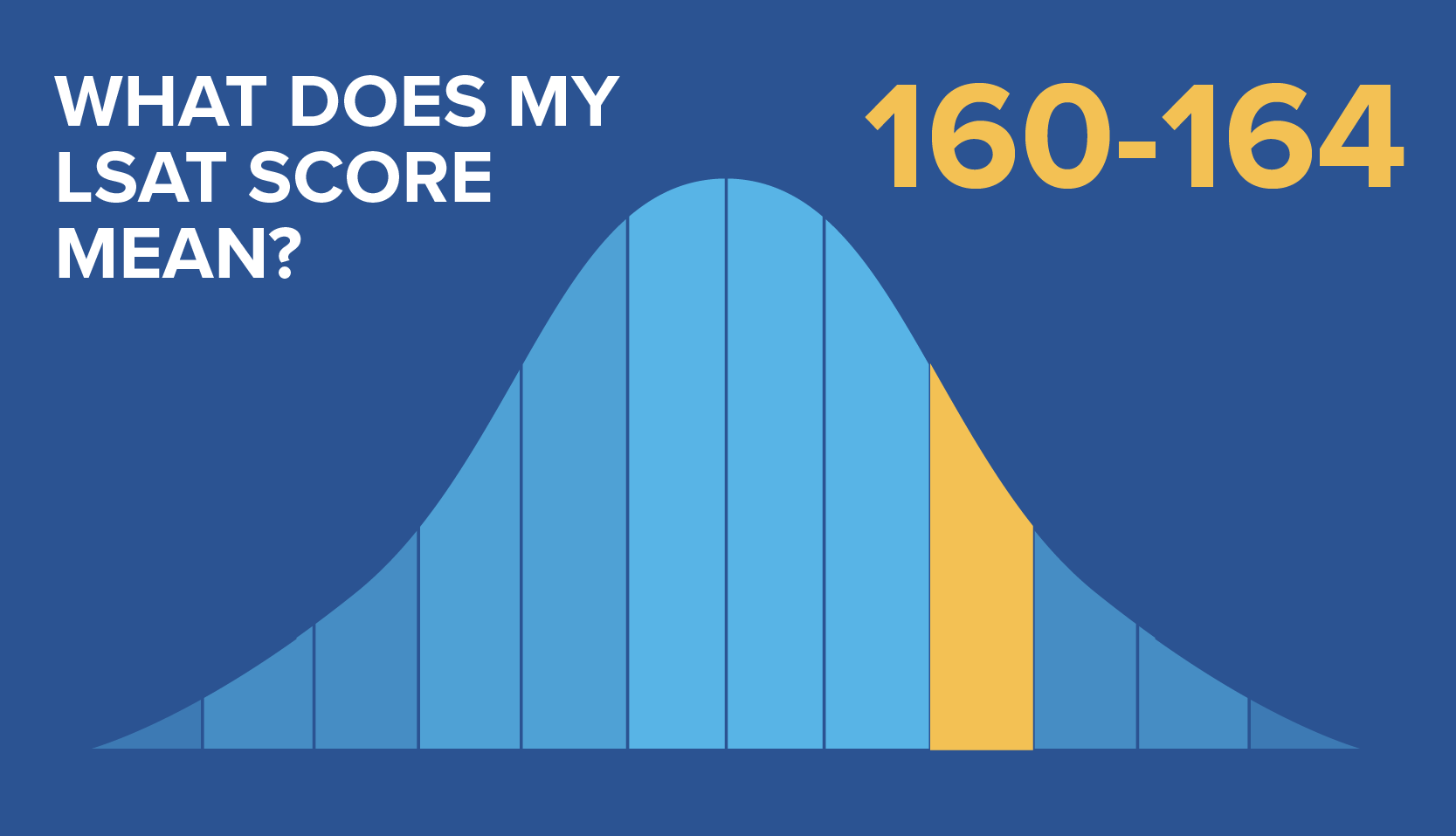This article was last updated June 2024.
We know that with the launch of our new score-related series, many LSAT test takers who aren’t within the 165-172 or 155-159 bands are waiting with bated breath for our next release. It’s happening, people. It’s time to talk about those in-between LSAT scores, the 160-164s.
As with our last post in the series, we’re going to take a closer look into what different LSAT scores mean for you – the types of law schools (and law school scholarships) you might want to aim for, and how those factors can impact your later job prospects and potential salary range. Grab a snack and get to scrolling: the 160-164 review is here!
What Does My LSAT Score Mean?
First off, if you’re in this score range, you’re already officially above the mean (and above median, though we can’t speak to mode – sorry stats fans). Within this score range, you’re besting 82-91 percent of your peers, putting you solidly into the top quarter of test takers! So, what does that mean in practical terms?
Let’s start with the good news: Scoring in this range does make you competitive for a variety of law schools. It’s not going to be sufficient for the very top programs, but there are many law schools that would be happy to see scores in this range!
The following is a list of the schools with median LSAT scores in the 160-164 range for admitted full-time student populations at these schools as of Fall 2024. Don’t forget, this list isn’t exclusive or exhaustive, and some schools are excluded as their average entering score is actually lower than 160.
| Law School | Median LSAT Score |
| Lewis & Clark College (Northwestern) | 160 |
| Georgia State University | 160 |
| Case Western Reserve University | 160 |
| University of Kansas | 160 |
| University of Nevada – Las Vegas | 160 |
| University of Pittsburgh | 160 |
| University of Denver (Sturm) | 160 |
| University of Connecticut | 160 |
| Florida International University | 160 |
| Seton Hall | 160 |
| University of Missouri | 160 |
| University of South Carolina | 160 |
| Tulane University | 161 |
| University of San Diego | 161 |
| Pennsylvania State University – University Park | 161 |
| Loyola Marymount University | 161 |
| University of Houston Law Center | 161 |
| University of Miami | 162 |
| St. John’s University | 162 |
| University of Tennessee–Knoxville | 162 |
| American University (Washington) | 162 |
| Wayne State University | 162 |
| University of Maryland (Carey) | 163 |
| Northeastern University | 163 |
| Temple University (Beasley) | 163 |
| University of Arizona (Rogers) | 163 |
| University of Iowa | 163 |
| University of Utah – Quinney | 164 |
| Villanova University | 164 |
| University of Washington | 164 |
| University Indiana University-Bloomington | 164 |
| University of Colorado-Boulder | 164 |
| Yeshiva University (Cardozo) | 164 |
| Southern Methodist University (Dedman) | 164 |
| University of Richmond | 164 |
| Baylor University | 164 |
| Pepperdine University (Caruso) | 164 |
Sources: U.S. Department of Education, U.S. News & World Report.
As you can see, you’ve got a lot of options! No, the T14 probably aren’t a good fit for you if you’re in this score range, but you’re still looking at a pretty solid (and lengthy) list of law schools. If you’re surprised that your dream program isn’t on this list, we recommend taking a look at the overall school rankings and seeing the average scores for the programs you were hoping to apply to – you may want to expand your list.
That said, remember that these are average score values, so an exceptional application may squeeze you into a more prestigious program, even with your current LSAT score, though by the same token, having the average score isn’t a guarantee you’ll get in, especially if your application is otherwise lacking.
While we’re talking admissions, we may as well address the elephant in the room: money. What can someone scoring in this range expect to see in scholarships? This data gets pretty complex, as most scholarships (both those specific to a program and those not associated with a specific school) rely on several metrics outside of LSAT score. With a good LSAT score of 160-164, your LSAT score may well qualify you for some cash at some of the lower-ranked law schools!
If cost is a big concern for you, consider applying to schools with lower median scores than your current average (take a look at our 155-159 score post to see that list), where you may be more likely to get scholarship money for a score in the 160-164 range. While you’re equipped for admission into many programs, your biggest competition for scholarships offered by your program will be individuals who have LSAT scores significantly higher than the admissions median. With your score, to some extent, you’re going to need to choose between program prestige and the likelihood of financial assistance.
So, okay, scholarship info is a little less definite than we’d like to see. But what about that sweet, sweet cash awaiting you at the far end of the law school rainbow? Eventually (hopefully), you won’t even bat an eye at $14 cocktails or restaurants with three dollar signs next to their names on Yelp. In addition to money, job security is a big issue — how do these scores and schools correlate to immediate employment at graduation? Let’s take a deep dive into some of the schools listed above:
| School | Employed Immediately | Median Private Salary | Median Public Salary |
| University of Richmond | 70.6% | $120,000 | $62,499 |
| Loyola Marymount University | 50% | $62,499 |
$62,499
|
| University of Iowa | 83.9% |
$110,000
|
$59,280
|
| University of Colorado-Boulder | 65.1% | $105,000 |
$59,208
|
| University of San Diego | 56.3% |
$105,000
|
$50,413
|
| Case Western Reserve University | 53% | $95,000 |
$64,630
|
| University of Kansas | 81.8% | $85,000 | $63,000 |
Sources: U.S. Department of Education, U.S. News & World Report.
As you can see, there’s some variance from school to school across all of these metrics. Across the board, though, you’re looking at an average of a 65% chance at a job right after graduation. This means you’ll probably want to be a bit proactive to ensure you are able to find a position. The good news is that compensation in both the public and private sectors isn’t maxed out; these figures represent median salaries and therefore there is room to shoot for the stars.
But how do those private sector median salaries compare to overall starting salaries? This data set is a bit older, but still very indicative of the distribution of JD starting salary for graduates:
Note that, with programs like the ones you’re looking at with your LSAT score, you may well have 6 figures in your future! That will of course vary depending on specialty, region of the US, etc. To make sure you’re getting the most out of law school, do a bit of research ahead of time on median salaries in the area of practice you’re interested in, and look at your program’s specific stats for future employment in that area. If you’re going into the public sector, it is worth it to do some in-depth research and figure out what option is going to do the best for you in terms of finding a job.
So, if you’re in this range of scores, you’ve got a range of options when it comes to school, your pay outlook as a lawyer is pretty darn good, but you might be in debt for a while if you don’t qualify for other forms of financial aid (or other help) to pay for law school and you aim for a school that has a median near your score.
Your LSAT score may help schools forgive some small gaps if you’re applying to places with a significantly lower median than your score. However, your score isn’t going to be quite high enough to compensate for big gaps in GPA, so make sure you’re taking the time to refine every element of your application, and you’ll have decent odds of getting into a well-ranked school.
Is your goal score in this range or did you score here and are aiming higher? We can help you reach your goal score! Get access to a bunch of free LSAT resources when you create a Blueprint LSAT account and start your LSAT journey!






